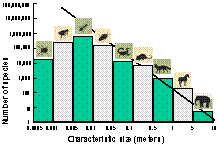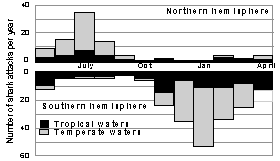
Welcome to Poorna Pal's
Updated on 05.05.15

Oceanography Pages at the Glendale Community College
Ocean-115: Sample Quiz 3
 |
Welcome to Poorna Pal's |
Updated on 05.05.15 |
 |
||
|
Oceanography Pages at the Glendale Community College |
|||||
|
Ocean-115: Sample Quiz 3 |
|||||
|
|
|||||
|
|
|||
|
|
Home | My Book | Physical Geol: Geol-101, Geol-111 | Environmental Geol: Geol-102, Geol-112 | Oceanography: Ocean-115, Ocean-116 |
|
|
|
On this page:
|
|
|
True |
False |
|
|
|
|
Longshore current off the California coast travels polewards from the equator. | ||
|
|
Longshore current often reduces the coastline’s pre-existing irregularity. | ||
| We measure the biological activity on earth in grams of carbon per square meter per year. | |||
| Biological productivity in the oceans usually requires availability of nutrients in Sun-lit waters. | |||
| Algae, whether marine or on the land, are the most primitive members of the animal kingdom. | |||
| Estuaries and upwellings have intense biological productivity because strong wave activity dissolves CO2 better in these Sun-lit waters. | |||
| A delta typically forms from the accumulation of land-derived sediments at the mouth of a river. | |||
| Coastal constructions like groins and breakwater walls have no effect on the longshore current. | |||
| Primary biological productivity, measured in grams of carbon per square meter per year, can be autotrophic as well as heterotrophic. | |||
| Sea urchin is a marine vertebrate that generally prefers cold waters. | |||
| The cnidaria like jellyfish, corals and sea anemones are the examples of marine vertebrates. | |||
| Mutualistic symbiosis is the inter-relationship of two species in which one is always an autotroph and the other a heterotroph. | |||
| Countershading is an example of how organisms adapt to their natural habitat. |
 |
Multiple-Choice Questions |
|
|
|
||||||||
|
|
|
Group it under the plant kingdom if it is heterotrophic. |
|||||||
|
|
It is autrotrophic if it synthesizes carbohydrates. |
 |
|||||||
|
|
It is a bacterial decomposer if it chemosynthesizes.
|
||||||||
|
|||||||||
| the longshore current here flows northwards? | |||||||||
| the longshore current here flows southwards? | |||||||||
|
sand accretion rate (i.e., rate of
accumulation or deposition) here is ~100 cubic yards per year? |
|||||||||
|
 |
||||||||
| Zooplanktons are symbionts, and phytoplanktons the hosts, in the symbiotic relationship displayed here. | |||||||||
| Phytoplanktons bloom in spring and autumn, in these temperate latitude waters, because nutrients then become available in the photic zone. | |||||||||
|
The biological productivity on eastern
margins of tropical ocean is poor during the El Niño events. |
|||||||||
|
|||||||||
| Kelp, a large brown algae (a thallophytae), prefers cooler waters of the temperate latitudes whereas mangroves, the marine spermato-phytae or seed-bearing plants, inhabit the tropical coasts. |
 |
||||||||
| Strictly marine amphibians and birds are unlikely, as their evolution itself implies the adaptation to an environment that was not exclusively marine. | |||||||||
| Oceans abound in thallophytae, and carry some spermatophytae at the continental margins, but have no bryophytae and pteridophytae. | |||||||||
|
 |
||||||||
| Estuaries. |
|
Coral reefs. | |||||||
| Circum-Antarctic waters. |
|
Temperate latitude waters. | |||||||
|
||||||||||||
|
|
|
Surface waters have high biological activity all the world over because they are Sunlit. |

|
|||||||||
|
|
|
The total primary production of open oceans is far less in proportion to their surface area. | ||||||||||
|
|
|
Total primary production in “upwelling” regions is so small, despite the high biological production "rate", | ||||||||||
| because primary biological production here occurs only in the ocean surface waters. | ||||||||||||
|
 |
|||||||||||
|
|
|
we must have more microscopic life-forms than have been identified as yet. | ||||||||||
|
|
the future discoveries of animal species will include more vertebrates than invertebrates. | |||||||||||
|
|
Coastal and divergence regions produce most of the seafood that we need. | |||||||||||
|
|
||||||||||||
|
 |
|||||||||||
|
|
|
Shark attacks are frequent in July in temperate regions of northern hemisphere, and in January in the temperate regions of southern hemisphere, because sharks migrate from northern hemisphere in July to the southern hemisphere in January. | ||||||||||
|
|
|
As sharks are predators, and typically feed on seals, their migrations across the two hemispheres reflect the pattern of seals' migrations. | ||||||||||
|
|
|
Shark attacks are most frequent in the summertime at temperate latitudes. | ||||||||||
|
|
||||||||||||
|
||||||||||||
|
 |
|||||||||||
|
|
|
parasitic symbiosis |
|
|
commensalistic | |||||||
|
|
|
mutualistic symbiosis |
|
symbiosis | ||||||||
 |
Short notes
|
|
|
Home | My Book | Physical Geol: Geol-101, Geol-111 | Environmental Geol: Geol-102, Geol-112 | Oceanography: Ocean-115, Ocean-116
This site was last updated on 05/05/15